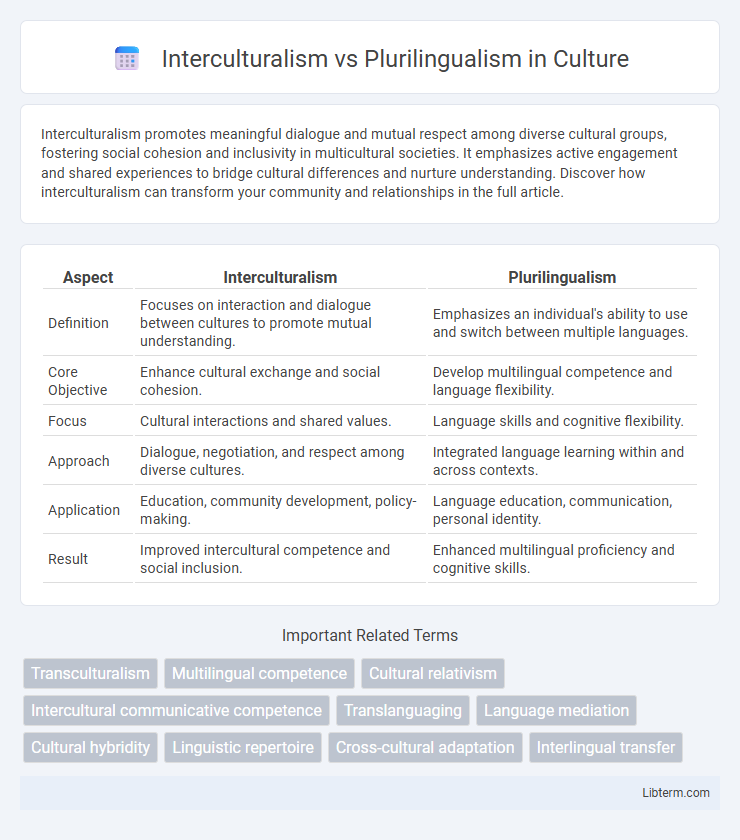Interculturalism promotes meaningful dialogue and mutual respect among diverse cultural groups, fostering social cohesion and inclusivity in multicultural societies. It emphasizes active engagement and shared experiences to bridge cultural differences and nurture understanding. Discover how interculturalism can transform your community and relationships in the full article.
Table of Comparison
| Aspect | Interculturalism | Plurilingualism |
|---|---|---|
| Definition | Focuses on interaction and dialogue between cultures to promote mutual understanding. | Emphasizes an individual's ability to use and switch between multiple languages. |
| Core Objective | Enhance cultural exchange and social cohesion. | Develop multilingual competence and language flexibility. |
| Focus | Cultural interactions and shared values. | Language skills and cognitive flexibility. |
| Approach | Dialogue, negotiation, and respect among diverse cultures. | Integrated language learning within and across contexts. |
| Application | Education, community development, policy-making. | Language education, communication, personal identity. |
| Result | Improved intercultural competence and social inclusion. | Enhanced multilingual proficiency and cognitive skills. |
Defining Interculturalism: Core Concepts
Interculturalism emphasizes dialogue, mutual respect, and interaction between different cultural groups, fostering social cohesion and shared values within diverse societies. It promotes understanding and exchange beyond mere coexistence, encouraging active engagement and collaboration among cultures. Core concepts include cultural recognition, inclusion, and the negotiation of identities through continuous intercultural communication and learning.
Understanding Plurilingualism: Key Principles
Plurilingualism emphasizes the ability of an individual to use and switch between multiple languages within various contexts, reflecting a dynamic and integrated linguistic repertoire. This approach values language diversity as a fluid and personal resource, promoting intercultural competence by enabling communication across cultural boundaries. Key principles include fostering flexible language skills, encouraging interaction among languages, and supporting identity development through multilingual practices.
Historical Contexts: Origins of Both Approaches
Interculturalism originated in the late 20th century, primarily in Quebec, as a response to multiculturalism's perceived limitations, emphasizing active dialogue and interaction between cultural groups. Plurilingualism stems from European language education policies promoting the simultaneous use and learning of multiple languages within individuals, rooted in the 1990s Council of Europe frameworks. Both approaches arise from distinct historical contexts: interculturalism addresses social cohesion in culturally diverse societies, while plurilingualism targets linguistic competence and educational reform in multilingual environments.
Social Implications in Multicultural Societies
Interculturalism promotes social cohesion by encouraging dialogue and mutual respect among diverse cultural groups, fostering inclusive policies that address minority rights and social integration. Plurilingualism emphasizes individual linguistic competence across multiple languages, enhancing communication skills and cognitive flexibility, which supports social mobility and economic participation in multicultural societies. Both frameworks contribute to reducing social barriers and promoting equity, with interculturalism focusing on collective identity and dialogue, while plurilingualism centers on personal language repertoire and adaptability.
Educational Impact: Classroom Applications
Interculturalism in education promotes active dialogue and mutual understanding among students from diverse cultural backgrounds, fostering empathy and collaborative skills. Plurilingualism emphasizes the development of multiple language competencies within a single learner, enhancing cognitive flexibility and communication abilities across linguistic contexts. Classroom applications of interculturalism often include culturally responsive teaching and experiential learning, while plurilingualism integrates translanguaging practices and dynamic language use to support multilingual competence.
Language Policy and Legislation Differences
Interculturalism emphasizes fostering social cohesion and mutual respect through language policies that prioritize integration and cultural dialogue, often enshrined in legislation promoting official bilingualism or multilingualism within specific territorial boundaries. Plurilingualism is reflected in policies that encourage the individual's ability to use multiple languages flexibly, with legislation supporting education systems designed to develop diverse linguistic repertoires rather than enforcing dominant-language norms. The distinction lies in interculturalism's collective focus on societal unity through language legislation, while plurilingualism centers on individual multilingual capacities within educational policy frameworks.
Identity, Belonging, and Cultural Expression
Interculturalism emphasizes dialogue and interaction between distinct cultural identities to foster mutual respect and a shared sense of belonging within diverse societies. Plurilingualism highlights the fluidity of linguistic repertoires, allowing individuals to express multiple cultural identities and navigate different social contexts seamlessly. Both concepts reinforce cultural expression by recognizing the dynamic and evolving nature of identity in multicultural environments.
Case Studies: Success Stories and Challenges
Case studies of interculturalism highlight successful integration models in Canada and New Zealand, where policies foster mutual respect and cultural exchange among diverse communities. Plurilingualism is exemplified by the European Union's education initiatives, promoting proficiency in multiple languages to enhance cognitive flexibility and social cohesion. Challenges in both approaches include overcoming linguistic barriers and addressing identity conflicts within multicultural societies.
Intercultural vs. Plurilingual Competence Development
Intercultural competence development emphasizes understanding and navigating cultural differences through empathy, communication skills, and culturally responsive behavior, fostering meaningful interactions across diverse cultural contexts. Plurilingual competence development involves mastering multiple languages while integrating linguistic skills and cultural knowledge, enabling flexible and effective communication in varied linguistic environments. Both competences enhance global communication but target cultural awareness and language proficiency, respectively, contributing to comprehensive multicultural functionality.
Future Perspectives: Synergy or Divergence?
Interculturalism emphasizes mutual understanding and dialogue between distinct cultures, while plurilingualism promotes the fluid use of multiple languages within individuals. Future perspectives suggest potential synergy as integrating intercultural competence with plurilingual abilities can enhance global communication and social cohesion. However, divergence may arise if educational policies prioritize one approach over the other, affecting inclusivity and linguistic diversity strategies.
Interculturalism Infographic

 libterm.com
libterm.com